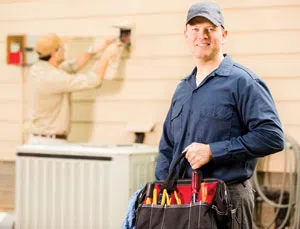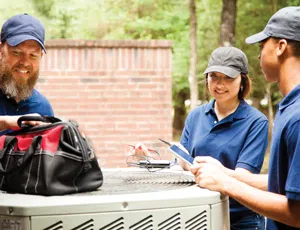Overcome the skills gap by educating, training and creating your own skilled workforce.
To understand what skills are important today for new hires to bring to the table, it is first important to know what your needs are for the technicians who work for you. This set of expectations should consider how the employee will grow with you — from their hiring to several years down the road — and should vary according to a new hire’s background.
Expecting a new technician straight out of college to do what an experienced technician can do is unrealistic. It is also important to know, in advance, what you, as the employer, are willing to invest in their development, as this will influence the type of new hire that would best fit your needs.
No matter how you define the specific qualifications your business requires of its technicians, there is one skill that envelops all contractors and is absolutely indispensable to business today: communication.
Being able to have a good dialogue with your customers is critical and, judging by the amount of training programs available to develop communication and other soft skills, the industry recognizes the need. It is crucial to evaluate a new technician’s communication skills and incorporate communication training — even if they are already a good communicator — as part of both new-hire and ongoing training.
As an employer, the technical skills you should be looking for depend on the resources you are willing to invest in upfront wages and benefits — and, in training.
Highly Developed Skills Rare
If you choose to seek qualified people rather than invest heavily in training, keep in mind highly skilled people tend to have more options for employment. In some cases, this creates competition among contractors looking for the same type of people, and, thus, you may have to pay more to reap the benefits.
The same can be true when considering college graduates — the most desired will be those instructors recommend without hesitation because the student has shown all the desirable aptitudes from day one of classes.
If you choose to hire more skilled talent up front, remember:
- They are easy to recognize, and you should feel confident you are getting what you pay for, as they come with an eager, wholehearted recommendation and/or stellar performance reviews.
- They are rare. Unfortunately, out of a class of 30 students, there may only be three to five of these ultra-high-performing students. It is no surprise they are usually all hired a month or more before they even graduate.
- For experienced technicians who have built a solid reputation, the same rules apply. However, the payoff is you can expect that they will be independent and add value from day one.
Identify Potential Talent
Harder to recognize are the students who do well but do not stand out as much among their peers because they may not have a strong extroverted personality. They, too, can be star employees if given a chance and, more importantly, support along the way through mentoring, ride-alongs and soft-skill classes.
They also make up a much larger part of the available talent pool, which is a strong plus for employers. I highly recommend you work with your local technical school(s), get to know the instructors and help them out in a way that is workable on your end. Instructors can be your best friends when it comes to helping you find and recognize good talent, and being around the students yourself allows you to observe them and see them at work first hand.
Do they show up late and unprepared for class or have an attitude you wouldn’t want associated with your business? If they do, does having a good score on an exam override these kinds of behaviors and personal skills?
Any graduate or prospective hire who can show up on time, demonstrate some technical competence and have a good work ethic should be a focus of your hiring efforts. The challenge is you will not be able to just give them a van, tools, GPS and send them off to fix stuff.
This can be a particular challenge for smaller contractors who may not have the senior technicians available to mentor and do ride-alongs with new hires as they learn the trade and develop the necessary skills.
Keep in mind, however, this is an investment, so it makes sense to use past interactions of potential hires with instructors and managers to help identify those with the skills required.
Once you have identified and hopefully hired someone with the attributes you desire, developing them is a continuation of your investment, like adding to any employer-provided benefit or retirement fund. In fact, it is pretty much the same as using the proceeds of the sale of your business to help you retire.
Since investing wisely is the name of the game here, you need to determine what your investment should look like six months, one year or even five years down the road. What you are looking for will change as time goes on, with the goal being the amount of investment diminishes with time while the value and return increases.
If you choose to seek and develop potential talent, remember:
- These workers will likely have a good work ethic, show up on time and do what they are capable of because they have already demonstrated this work pattern.
- They will have a desire to grow and learn new capabilities, as they will want the benefits that come with these new skills.
- You will need to invest in their development and it will likely take at least a year for them to become fully productive members of the team. The more expected of them, the longer the development time and investment period becomes.
- This type of hiring investment often lends itself to larger businesses that can invest the time of an experienced technician to help train and make do with a little less output from the experienced technician in terms of work completed during that period.
The first three to six months after a person is hired is generally the time when you will monitor, evaluate and decide whether or not a person will work out in their role and as part of your business.
Unfortunately, this is often used as an excuse to minimize investment in training and developing the person because of the fear of losing the investment if the person does not work out. While this may make sense if you just hired a person who claims to be experienced but you have little actual knowledge or testimonial of their past, it is counterintuitive if you have already invested in finding the person with the skills you already desire.
The whole purpose of working with schools to vet the better students from the rest is to quickly overcome the typical six-month probation period. Obviously, some caution is warranted, but do not risk losing good talent by not developing it early on if you have done your homework in hiring them.
One of my biggest recommendations is to ensure the new hire has access to a more senior technician.
Finally, it’s important to implement a set of ground rules for training ride-alongs. Make sure the new hire gets to see both how something is done and then provided a safe environment to try it themselves with supervision.
Give the senior technician several points to monitor so you can discuss later. This will allow you to then evaluate trends in development and overall performance. Also, it’s important to let the senior technician know you value the experience over the time it takes to complete a job, so they are assured they can spend the time needed to let the new technician learn.
Once the new hire develops a set of skills they can do on their own, you can send them out a few days a week to work alone. On the other days, have them travel with a senior technician to jobs that provide an opportunity to learn new skills and continue to build on what they have learned.
Ultimately, for a successful contracting business, finding technically strong employees with good communication and people skills is the goal — and a well considered and supported mentorship program is an excellent way to develop these.
Remember, a technician who has gone through a mentorship program can grow into a top-rated technician who remembers their experiences and makes a fantastic choice to mentor other future new hires, thus repeatedly paying back your investment.






